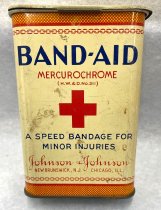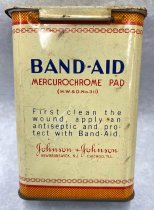Object Record
Images



Metadata
Title |
Band-Aid Container |
Object Name |
Container, Medicine |
Description |
Band-Aid Container, c. 1926-1939. Johnson & Johnson brand Band-Aid rectangular, lithographed, metal, container, with a hinged lid. The front of the container has text which reads, "BAND-AID // MERCUROCHROME // (H. W. & D. No. 311) // + // A SPEED BANDAGE FOR // MINOR INJURIES". Below that text, in script, it reads, "Johnson & Johnson". Below that it reads, in text, "NEW BRUNSWICK, N.J. CHICAGO, ILL.". The "+" is a large, red-cross symbol, which is the most visible symbol on the container. Above and below all the text, on the top and bottom ot the container is a band of red fishnet over a yellow background, with a stripe of red on the innner edge which wraps, horizontally around the entire container. Inside the fishnet designs, flanking the text, are red chain-link designs that run in horizontal bands around the entire container. The back of the contianer reads, "BAND-AID // MERCUROCHROME PAD // (H. W. & D. No. 311) // First clean the // would, apply an // antiseptic and pro- // text with Band-Aid." Below the text, in script, it reads, "Johnson & Johnson". Below the script it reads, in text, "NEW BRUNSWICK, N.J. CHICAGO, ILL." |
Date |
c. 1926-1939 |
Creator |
Johnson & Johnson |
Role |
Manufacturer |
Catalog Number |
1997.240.002 |
Dimensions |
H-3.5 W-2.375 D-1.125 inches |
Dimension Details |
3.5 x 2.375 x 1.125 |
Collection |
3D - Medical & Psychological Tools & Equipment |
Notes |
"When the company was founded in 1886, sterile packaging wasn’t yet available—so delivering its surgical supplies and household hygiene products to hospitals and consumers required ingenuity and design smarts. Here’s the story of the changing face of packaging at Johnson & Johnson. There’s nothing unusual about a fruit jar filled with homemade strawberry jam. But what about a fruit jar packed with sterile sutures, dressings and medical gauze? It sounds strange, but in the early 1900s, that’s how Johnson & Johnson packaged some of its sterile surgical products to make sure they could be sold and delivered safely in an era before hygienically sealed containers. As the 20th century progressed, so too did packaging innovations, including a wide variety of containers specifically designed to keep home health items hygienic. As a result, Johnson & Johnson’s products became not just better at keeping people healthy—but easier to use, too. (Tooth "cream" in a squeezable metal tube? It was a brilliant innovation in 1889!) The company also made labels and packages more aesthetically appealing to consumers, updating the look of products to align with changing design styles and tastes. When they first hit store shelves in 1921, BAND-AID® Brand Adhesive Bandages came in cardboard boxes. But in 1926, Johnson & Johnson began selling them in flat, square tin containers. The tins became as popular as the bandages themselves and were typically repurposed to hold small household items like coins, nails or buttons, says Gurowitz. The tins changed style and shape over the decades (the tin in the photo above dates back to the 1930s), and many are now prized collector’s items. In 1994, the company switched back to cardboard boxes." "11 innovative ways Johnson & Johnson packaged its earliest products" by Esther Crain. Published by Johnson & Johnson: Our Heritage, on December 19, 2022. [https://www.jnj.com/our-heritage/11-innovative-ways-johnson-johnson-packaged-its-earliest-products] |
Credit line |
Courtesy of San Mateo County Parks and Recreation |
